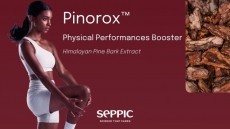Combined EPA and DHA intake may benefit physical performance: Japanese review

Fish oil contains high levels of omega-3 fatty acids, mainly eicosapentaenoic acid (EPA) and docosahexaenoic acid (DHA), that are said to be effective in enhancing cardiac and cognitive function, as well as reducing blood pressure and depression.
Previous studies have shown that EPA and DHA consumption improved endurance performance and fatigue recovery, as well as antioxidant and anti-inflammatory responses. It also helped to maintain immune function, minimise delayed-onset muscle soreness (DOMS).
However, the optimal dose and duration of EPA and DHA supplementation to maximise the aforementioned effects remain unclear.
Do fats aid muscle?
Researchers at Japan's Hosei University and Teikyo Heisei University conducted a review on the effects of EPA and DHA on muscle and nerve damage, as well as muscle mass and strength, as reported in both human and animal trials.
In terms of muscle strength deficit, they observed that when combined, the effects of EPA and DHA supplementation on strength loss after eccentric contractions had been 'controversial'. Some studies had shown no significant difference in muscle strength decrease after EPA and DHA intake.
However, those studies had taken place over three to four weeks, and EPA and DHA supplementation had been reported to require 30 to 60 days to effectively inhibit muscle strength deficit.
The researchers added: "Regarding serum inflammatory markers after eccentric contractions, EPA and DHA supplementation inhibit elevated tumour necrosis factor-α (TNF-α) and interleukin-6 (IL-6), which are inflammatory markers in the blood."
When it came to DOMS, they stated that EPA and DHA demonstrated a dose-dependent effect: 0.6g/day of EPA and 0.26g/day of DHA for eight weeks had positive results, and a ratio of 2:1 was recommended for a synergistic impact on attenuating DOMS.
Neuromuscular damage was also reported to be reduced by EPA and DHA supplementation, but only one study — conducted on diabetic rats — was reviewed, necessitating further research in this area.
In addition, EPA and DHA were said to prevent decreases in muscle mass in animal trials, but human studies on this effect have been limited so far, with discrepancies noted among different trials.
While older adults aged 60 to 85 who had ingested 1.86g of EPA and 1.5g of DHA daily for six months experienced growth in thigh muscle mass, younger men (aged 21 to 24) who had taken 3.5g of EPA and 0.9g of DHA daily before and after high-intensity exercise did not display any such benefits, leaving the role of EPA and DHA in muscle mass under training conditions unclear.
More needed on mechanisms
The researchers wrote: "EPA and DHA are effective for neuromuscular adaptation after training. One possible mechanism for this effect is an increase in the incorporation of omega-3 fatty acids in the cells, particularly in the nerve and muscle."
They added, however, that the precise biological mechanisms underlying EPA and DHA's positive impact on muscle and neuron are unknown, and that further studies were needed to determine these mechanisms.
They concluded: "EPA and DHA have several positive roles for exercise damage and function. Unfortunately, currently, there are no clarified optimal periods and dosages for EPA and DHA. Therefore, it is necessary to investigate appropriate conditions considering age, sex, exercise experience, diseases, etc. in the future.
"Regarding dosage, it should be noted that the amount of EPA and DHA is limited to a total of 3g per day for safety in humans by the natural medicines comprehensive database.
"In particular, the ingestion of single EPA or DHA did not elicit attenuation in several muscle damage markers. Hence, we speculate that EPA and DHA might have different roles, and thereby simultaneous ingestion of EPA and DHA has a possible synergistic effect.
"In the future, varied ingestion periods (and) doses, of either EPA or DHA, or the synergistic effects of the simultaneous ingestion of both, need to be investigated in other interventions, including muscle and nerve damage, and training."
Source: Nutrients
https://doi.org/10.3390/nu10050552
"Eicosahexanoic Acid (EPA) and Docosahexanoic Acid (DHA) in Muscle Damage and Function"
Authors: Eisuke Ochi, Yosuke Tsuchiya
















